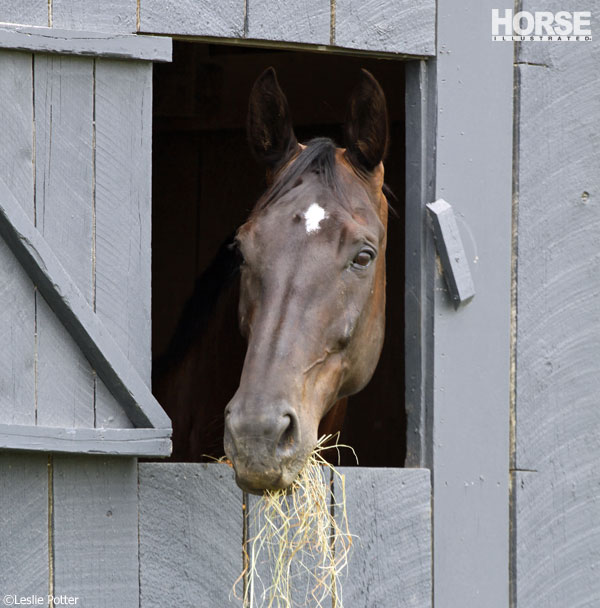
Alfalfa
Abundant in protein and calcium, alfalfa is a good source of forage for young, growing horses and lactating mares. For most other horses, it can be too rich and lead to obesity. The high protein concentration can lead to excess nitrogen intake, which is excreted in the urine, causing a pungent ammonia smell in the stable. Western states in particular grow a lot of alfalfa and tend to feed it in the form of hay cubes because baled hay is harder to come by in these areas.
Beet Pulp
Beet pulp is a high-fiber roughage source that is easily digested by horses. Since it is purchased in dry form and expands when wet, you should soak it for a length of time before feeding it to your horse. It does not contain sufficient potassium for the horse’s diet, however, so if fed in large amounts as a fiber source, potassium must be supplemented. Molasses will add potassium, but it is made mainly of sugar. Although flavorful, too much sugar can upset the horse’s digestive system. Many pre-formulated mixed feeds contain beet pulp to increase fiber content and will have the correct nutrient balance.
Concentrates
Concentrates are grain mixtures formulated specifically for horses as a concentrated source of energy (calories). They provide much more energy per pound than hay or pasture, so be careful not to overfeed these. The horse’s digestive tract is not equipped to handle large meals of starchy carbohydrates, so it is best to feed only small amounts of grain at a time, preferably dividing them into at least three meals a day. This will still keep your horse at a good weight. Most lightly worked horses will maintain condition from high-quality hay or pasture grazing alone. Only horses in moderate or heavy work will need the added calories supplied by grain. If you opt to feed concentrates, do not exceed the amount specified by the manufacturer, and store feed in air-tight containers where loose horses and barn pests cannot get into it.
Digestion
The digestive system of a horse works very differently from that of a human. Food passes quickly through a relatively small stomach designed to take in frequent meals throughout the course of the day. In the small intestine, enzymes digest starch, protein and fat.
The “hindgut” of the horse is made up of the cecum (a pouch between the small and large intestine), the small intestine, the large intestine and the rectum. The hindgut contains a beneficial bacteria population that breaks down fibrous plant material into energy that the horse can use as fuel.
Horses cannot vomit and are therefore more prone to digestive disruptions, such as choke and colic, than other animals.
Exercise
In general, horses that are properly fed are more likely to be too fat than too thin. If you have a healthy but overweight “couch potato” horse that is just fed hay and/or a reasonable amount of pasture (i.e., no grain), it’s time to increase the exercise regimen to get him to a healthy body condition. As with humans, a good diet should always be combined with reasonable exercise to promote the best possible health.
Fiber
Unlike humans, horses are able to extract energy from the fiber in their diet. The fiber is converted to volatile fatty acids (VFAs) by a bacterial fermentation process in the hindgut; the VFAs are then used to synthesize glucose (sugar) for immediate energy or are converted to fat for storage.
Horses need to eat a large amount of fiber each day to keep their gut active and free of problems, such as colic. A strong urge to chew on fibrous material also means horses may develop vices such as wood-chewing and stall-walking if they become bored without hay or pasture to consume. Since horses can handle only small amounts of concentrated energy in the form of grain, the bulk of the diet should be free-choice forage (hay or pasture), preferably with a lot of natural long-stem matter as opposed to pelleted hay or small cubes.
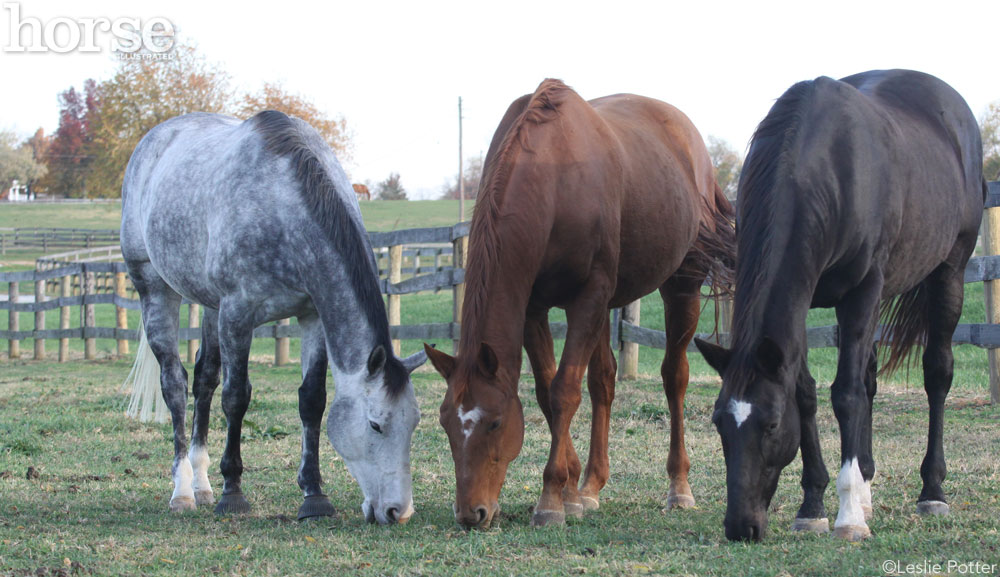
Grazing
Good-quality pasture is a wonderful source of energy, protein, fiber and vitamins. Horses enjoy grazing and are designed to move around, eating grass in a herd situation. In most areas, however, pasture space is limited and careful maintenance is required to keep turnout time healthy and productive. Regularly removing manure helps break the fly and parasite life cycles, while resting fields by rotating horses to other paddocks will allow grass to recover and keep undesirable weeds to a minimum.
Hay
When purchasing hay for your horse, assess its freshness; it should not be dusty or smell moldy or musty. Moldy hay contributes to respiratory ailments in horses. The more mature the hay is when it’s harvested, the more stemmy and high in fiber/low in protein it will be. While this may be nutritionally adequate for lightly ridden horses and easy keepers, it is also less palatable and may not get eaten at all.
Hay cut earlier has more leafy material, calories and protein. Horses are usually quite eager to eat it, but it may also lead to weight gain if fed free-choice. A good idea is to feed the “younger,” tastier hay at meal time and leave the more mature hay available free-choice for snacking on whenever the horse wants something to keep him busy.
The two types of hay are grass and legume. Examples of grass hay are orchard grass, Bermuda grass and timothy. Legume hays include alfalfa and clover. Many hay producers grow mixed fields for “combination” hay—for example, orchardgrass and clover.
Insulin Resistance
When starches and sugars are consumed, the body releases insulin, a hormone that cues absorption and storage of sugar from the bloodstream. Overfeeding starch and sugars can make horses “insulin resistant,” meaning the body cannot absorb glucose properly to fuel the body.
Although obese horses are more at risk for insulin resistance, it also occurs in horses of normal weight. The condition is known to be associated with repeated bouts of laminitis. Although there is no cure, insulin resistance can be controlled by managing or eliminating concentrates, grains and lush pasture from the diet.
Joint Supplements
Arthritis and degenerative joint disease are common problems in performance horses. They can often be managed with joint supplements that allow a horse to continue a useful athletic career. These can be administered topically, orally, intramuscularly, intravenously or intra-articularly (directly into the joint).
Common oral supplements include glucosamine, chondroitin sulfate, hyaluronic acid, methylsulfonylmethane (MSM) and avocado soybean unsaponifiable extracts (ASU). Limited studies have been done on orally administered joint supplements, but the data suggest they may be helpful in controlling and even protecting against certain joint problems.
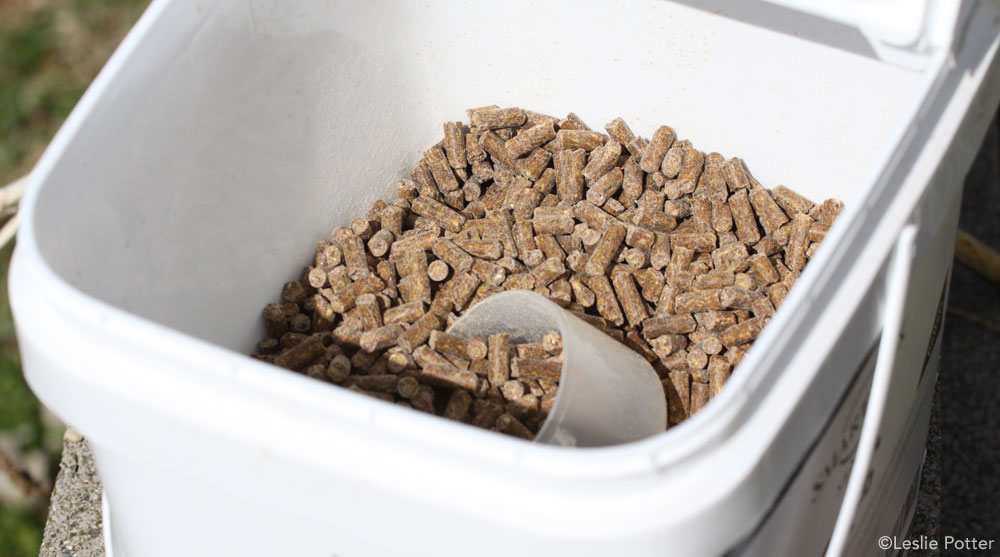
Kentucky Bluegrass
Kentucky bluegrass is a cool-season grass (Poa pratensis) that grows best in spring and fall, and resists trampling and close grazing quite well. It is found in lawns and horse pastures across the nation due to its ability to grow in most soils and to withstand cold.
Laminitis
Also called founder, this disease is a painful inflammation of the tissue within the foot that connects the hoof wall to the coffin bone. It can cause extreme lameness and may require euthanasia. It most commonly occurs in the front hooves. In severe cases, the coffin bone inside the hoof tears away from the hoof wall and rotates downward, causing a permanent need for corrective trimming and shoeing.
The exact physical mechanism that causes laminitis is still somewhat of a mystery, but many of the triggers are well-known. For instance, ponies and easy-keeping or overweight horses tend to be most prone to laminitis when allowed to eat large quantities of lush grass. Particularly in the springtime, grass stores a sugar called fructan, which has been linked to triggering laminitis. Fructan levels vary widely in different types of grass, from region to region, throughout the year, and even throughout the day.
If your horse has a history of severe laminitis (which your veterinarian can determine by looking at and X-raying his hooves), he is much more likely to be predisposed to another bout, so you should be particularly vigilant about limiting his turnout on grass or use a grazing muzzle. Turning him out in a dirt paddock (“dry lot”) with plenty of mature hay to munch on is usually the best solution for keeping him healthy.
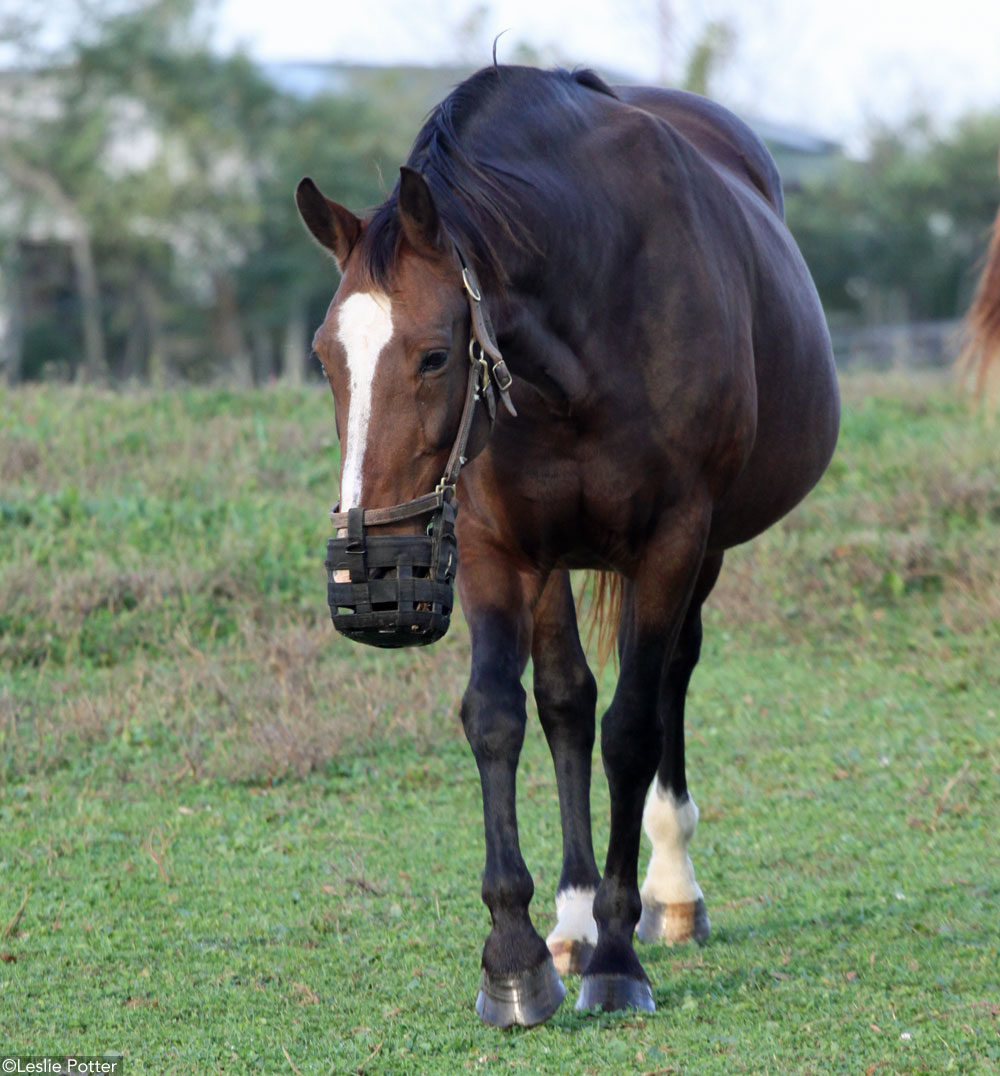
Microbes
The microbes in a horse’s hindgut include beneficial bacteria, protozoa and fungi. These unseen friends ferment fiber coming through the digestive tract, releasing carbon dioxide, VFAs and a small amount of methane. As mentioned previously, the VFAs are readily absorbed and converted to energy. In fact, it has been shown that 30 percent or more of the horse’s total energy is derived from VFAs.
The important thing to remember about this energy production is that you’re not only feeding your horse, you’re feeding the good bacteria, as well. They require a steady stream of fiber to do their job and keep your horse healthy. Digestive disturbances can occur if the horse’s feed changes suddenly, leading to the death of certain bacteria, which then release endotoxins into the horse’s system. Endotoxins can trigger colic or laminitis, potentially fatal conditions that—at the very minimum—will result in a costly vet bill.
Nutrients
The general categories of nutrients required by horses are energy, carbohydrates, protein, fat, vitamins, minerals and water. Keep this big picture in mind when thinking about how to divide up your horse’s daily feeding regimen. Energy in the form of carbohydrates (mainly from fiber) should make up the great majority of a horse’s feed intake. Protein and fat are not required in large amounts in lightly worked mature horses, and vitamin and mineral needs are met with hay or pasture and a trace-mineral salt block.
Oil
Vegetable oil and other high-fat supplements are often used to increase the calorie content of feed for horses that have high energy requirements (such as hard keepers or those in heavy athletic work) without feeding large amounts of high-starch grain. Other benefits of adding oil or fat to the diet include a shiny coat and decreased excitability.
Corn oil is a palatable, high-fat product easily available to most horse owners. If you’re switching to a high-fat diet for your horse, begin slowly with small amounts and work up to the amount needed to keep your horse in good weight (while still providing adequate fiber) over at least two weeks’ time, so as not to suddenly disturb the microbe balance in the hindgut. For most horses, fat can be fed quite sparingly to meet energy needs, as too much can lead to obesity. Talk to your vet to see how much oil to feed your horse.
Protein
Adult horses in light work have relatively low protein requirements; if they are eating enough forage and concentrates to maintain good weight, they are probably not protein-deficient. Dietary forage in the form of legumes (including clover or alfalfa hay) is very high in protein. This particularly benefits young, growing horses and nursing mares, which have much higher protein requirements in order to supplement their developing foal.
Quality
It is important not to cut corners when it comes to feeding your horse. Cheap hay may seem to save money, but if it is moldy or filled with weeds and other contaminants (such as trash or dead animals), it can upset the digestive system and cause colic. Always inspect hay, grains and supplements, including oil, to be sure they are not moldy or rancid. If you are unsure, do not feed it.
Hay should look uniform from one bale to the next. Grain should smell fresh, and supplements should not be fed after they expire, or if they’ve been sitting in a hot feed room for too long. Always keep hay shaded and protected from rain (by a shed or tarps) to prevent nutrient loss from moisture and sunlight. Take good care of your horse’s feed, and it will take good care of your horse.
Rice Bran
Stabilized rice bran provides supplementary fat to the equine diet—but only about 30 percent by weight, versus nearly 100 percent fat in oil. However, it lasts longer on the shelf than vegetable oil.
A word of caution to keep in mind is that rice bran may have an inverted calcium-phosphorus ratio (more phosphorus than calcium, resulting in a calcium shortage). Therefore, additional calcium must come from other parts of the diet if you feed large amounts of rice bran.
Senior Horses
Older equines often have special dietary needs. Weight loss is a common problem, mainly due to poor dentition or metabolic problems. If a horse has lost some or all of his teeth, he may require a diet of soaked hay pellets to maintain a healthy weight.
Also available and convenient is equine “senior feed,” which is meant to be a complete source of nutrition, taking into account the special protein, vitamin and mineral requirements of the equine senior.
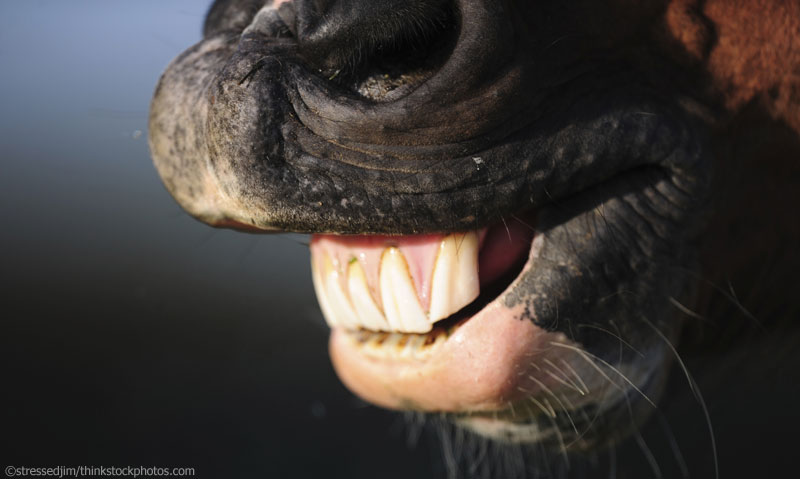
Teeth
The first stop along the digestive pathway for a horse’s feed is his mouth. The incisors clip grass and the molars grind hay, grass and grains before they are sent to the stomach. Since horses consume a lot of tough, stemmy material and incidental dirt and sand from the ground, teeth can be quickly and unevenly worn down. Since they grow continuously from the root throughout the horse’s life, it is important to have them rasped (or “floated”) to eliminate sharp edges that may cause the horse pain or lead to the inability to eat. A veterinarian should float your horse’s teeth at least once a year so he is comfortable chewing his food and can receive proper nutrition.
Ulcers
While we often think of ulcers as being a human condition, horses also suffer from this ailment. Some studies have found that as many as 80 to 90 percent of show and race horses are affected. Symptoms include poor body condition and a decline in athletic performance.
Management is critical to prevent ulcers from occurring in the first place. Feeding many small, high-roughage meals keeps the stomach busy and prevents acids from perforating its lining. Keeping horses on pasture as much as possible during the day, especially in a herd, is good for them mentally, and seems to be correlated with a decrease in ulcer occurrence.
Vitamins
The two most important supplementary vitamins for horses are A and E. When a horse is fed a diet entirely of hay, these nutrients may be insufficient because of how quickly they decline after forage is harvested and stored. Concentrates or low-calorie ration-balancers designed specifically for horses are usually formulated to complement a diet of hay and will provide adequate supplementation of these vitamins.
Water
It is critical for horses to always have access to clean, fresh water, which is more appealing when it’s not extremely hot or cold. Water is not only required for body fluid balance, but also for digestion and gastrointestinal health. Stagnant ponds are not an acceptable source of water.
Buckets and troughs that don’t refill automatically should be scrubbed daily, as water sitting in them can quickly become dirty. Automatic waterers should also be tended to regularly—both cleaned and inspected for leaks.
X = Weight
To accurately determine your horse’s weight without using a scale, use the following formula:
= (heart girth) x (heart girth) x (length) 330
This will give you a more accurate weight in pounds (for horses over one year of age) compared to using the commonly available “weight tapes.” For best results, use a 75-inch (or greater) plastic measuring tape, as fabric tends to stretch and metal tape measures do not bend enough. The heart girth circumference measurement should be taken straight down from the highest point of the withers, and length should be taken from the point of the shoulder to the point of the buttock (halfway around the buttock). Regularly measure your horse’s weight to see if his feeding program is keeping weight on him, or causing him to gain or lose too much weight.
Young Horses
Foals, weanlings and yearlings have different nutritional needs than mature horses. They generally require higher amounts of protein and calories than adult horses to ensure proper growth and development, but care must be taken not to overdo it.
There is some evidence linking rapid weight gain and obesity in young horses with bone and joint development problems that can affect the horse for the rest of his life. If you have a young horse, ask your vet to help design a healthy feeding program for his needs.
Zinc
Zinc is a micromineral found in many enzymes produced in the horse’s system and is rarely deficient in adult horses. Zinc is probably most important for its interaction with copper, as too much dietary zinc can create a copper deficiency. Copper deficiency is of greatest concern in foals, as there is evidence linking this to limb deformities and other developmental problems. Companies that manufacture equine feeds take the zinc/copper ratio into account and formulate the ratio of these minerals accordingly.
Your horse’s digestive system and the nutrients he needs work in a delicate balance to keep him healthy. Talk to your vet or go online to find your nearest county equine extension specialist (www.csrees.usda.gov/ Extension/index.html) to help you customize a diet appropriate for your horse.
Managing Editor Holly Werner Caccamise has an M.S. in Animal Science specializing in equine nutrition.
This article originally appeared in the 2010 issue of Horses USA.


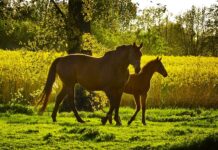


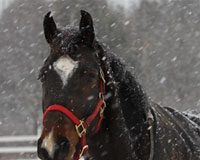

A very good basic article on nutrition. It can be hard to find good basics like this. It will help many people.
Thanks for the recap. I know so many people who unnecessarily feed their horses grain. It’s still a common misconception that all horses need it.